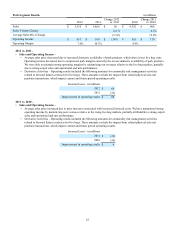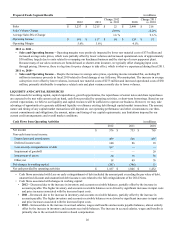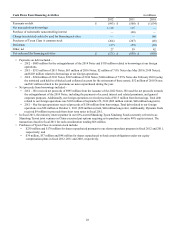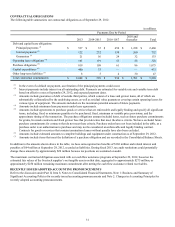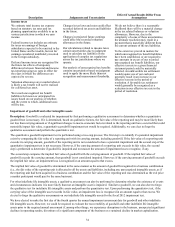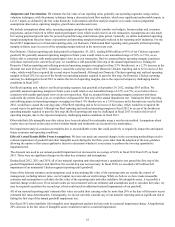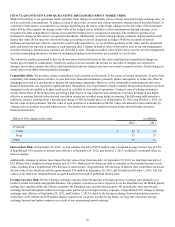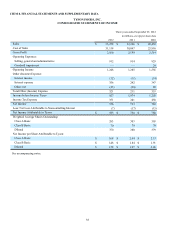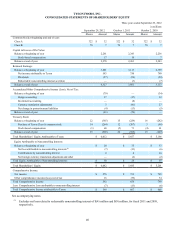Tyson Foods 2012 Annual Report Download - page 33
Download and view the complete annual report
Please find page 33 of the 2012 Tyson Foods annual report below. You can navigate through the pages in the report by either clicking on the pages listed below, or by using the keyword search tool below to find specific information within the annual report.
33
Description Judgments and Uncertainties Effect if Actual Results Differ From
Assumptions
Accrued self insurance
We are self insured for certain losses
related to health and welfare, workers’
compensation, auto liability and general
liability claims.
We use an independent third-party actuary
to assist in determining our self-insurance
liability. We and the actuary consider a
number of factors when estimating our
self-insurance liability, including claims
experience, demographic factors, severity
factors and other actuarial assumptions.
We periodically review our estimates and
assumptions with our third-party actuary
to assist us in determining the adequacy of
our self-insurance liability. Our policy is
to maintain an accrual within the central
to high point of the actuarial range.
Our self-insurance liability contains
uncertainties due to assumptions required
and judgment used.
Costs to settle our obligations, including
legal and healthcare costs, could increase
or decrease causing estimates of our self-
insurance liability to change.
Incident rates, including frequency and
severity, could increase or decrease
causing estimates in our self-insurance
liability to change.
We have not made any material changes
in the accounting methodology used to
establish our self-insurance liability
during the past three fiscal years.
We do not believe there is a reasonable
likelihood there will be a material change
in the estimates or assumptions used to
calculate our self-insurance liability.
However, if actual results are not
consistent with our estimates or
assumptions, we may be exposed to gains
or losses that could be material.
A 10% increase in the actuarial estimate at
September 29, 2012, would result in an
increase in the amount we recorded for
our self-insurance liability of
approximately $6 million. A 10% decrease
in the actuarial estimate at September 29,
2012, would result in a decrease in the
amount we recorded for our self-insurance
liability of approximately $23 million.
Impairment of long-lived assets
Long-lived assets are evaluated for
impairment whenever events or changes
in circumstances indicate the carrying
value may not be recoverable. Examples
include a significant adverse change in the
extent or manner in which we use a long-
lived asset or a change in its physical
condition.
When evaluating long-lived assets for
impairment, we compare the carrying
value of the asset to the asset’s estimated
undiscounted future cash flows. An
impairment is indicated if the estimated
future cash flows are less than the
carrying value of the asset. The
impairment is the excess of the carrying
value over the fair value of the long-lived
asset.
We recorded impairment charges related
to long-lived assets of $25 million, $15
million and $19 million, respectively, in
fiscal 2012, 2011 and 2010.
Our impairment analysis contains
uncertainties due to judgment in
assumptions and estimates surrounding
undiscounted future cash flows of the
long-lived asset, including forecasting
useful lives of assets and selecting the
discount rate that reflects the risk inherent
in future cash flows to determine fair
value.
Our Dynamic Fuels consolidated joint
venture began commercial operations in
October of 2010 and has incurred net
operating losses of $14 million and $24
million in fiscal 2012 and 2011,
respectively. The plant has experienced
mechanical difficulties, pre-treatment
system performance issues and hydrogen
supply disruptions, which have
contributed to plant down time and higher
than expected operational costs. Upgrades
to the feedstock pre-treatment systems and
improvements to the mechanical
reliability of the plant are currently
ongoing. If the plant upgrades and
improvements fail to improve operational
performance, or should industry
economics make the plant uneconomical
to operate, we may be required to assess
the recoverability of Dynamic Fuels' long-
lived assets to determine whether an
impairment exists.
Additionally, we continue to evaluate our
international operations and strategies,
which may expose us to future
impairment losses.
We have not made any material changes
in the accounting methodology used to
evaluate the impairment of long-lived
assets during the last three fiscal years.
We do not believe there is a reasonable
likelihood there will be a material change
in the estimates or assumptions used to
calculate impairments of long-lived assets.
However, if actual results are not
consistent with our estimates and
assumptions used to calculate estimated
future cash flows, we may be exposed to
impairment losses that could be material.




